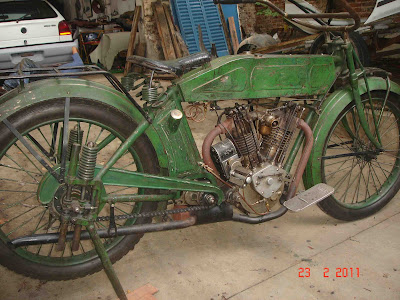A reader sent these photos of an unmolested ca. 1911 Pope motorcycle, imported in 1920 to a 'very wealthy family' in Argentina and now in the hands of a big collector, who would like to sell the machine.
Early American motorcycles are the biggest targets for fakery, but this looks to be a genuine machine, although of course, any six-figure bike demands a very hard look... and in this case, that look would require a trip to Buenos Aires, which doesn't sound so bad. For now though, take a gander at these photographs; instructive commentary/opinion is welcome!
The Pope Motorcycle Co was one of the first production motorcycles to use overhead valves (Hildebrand and Wolfmuller was first; four valves per cylinder too). With full suspension front and rear and that magnificent engine with shaft-driven magneto, plus all-chain drive and a proper clutch, the Pope was the most advanced production motorcycle in the world at that date, 14 years ahead of European bikes generally, and 25 years ahead of the first H-D production OHV machine - the 'Knucklehead' of 1936. JAP produced an OHV engine by 1906, but any English chassis would have been belt-drive and clutchless.
Founded by Albert Augustus Pope in 1878 (Harford, Connecticut), to build the 'Columbia High-Wheeler' bicycle, Pope purchased Pierre Lallemont's original patent for the bicycle. His canny business strategy of purchasing bicycle patents meant Pope collected royalties on the booming two-wheel market of the late 1800s, reaping huge profits. It also meant Pope bicycles owned cutting-edge technology, which made them the largest bicycle manufacturer until nearly 1900.
The Pope Manufacturing Co. began selling motorcycles in 1902, which they did not manufacture but were bought in, and re-badged as 'Columbia' (below). They took a break from motorcycles in 1906, but returned in 1911, making their own motorcycles under the 'Pope' name. True to their early bicycle form, they vaulted to the top of the technological heap, producing the very advanced v-twin as seen in these photos. Unlike the bicycle craze of the 1890s, the early years of motorcycling were hardly profitable for most companies, and advanced spec meant a higher price, just as for bicycles, but on a larger scale than a bicycle price range. A new 1911 Pope could well have been a year's wages for the average worker.
While Albert Augustus was a big supporter of bicycle racing events, teams, and trophies, I've only ever seen one period photograph of a Board Track racing Pope (below), but many photographs exist of converted roadsters. It seems unlikely that Pope funneled money into motorcycle racing - it could be the profits from his powered two-wheelers was disappointing, and as history tells us repeatedly, the motorcycle biz has always been very tough indeed.
At the advent of US involvement in WW1 (mid-1917), Pope chose to 'follow the money', and ceased motorcycle production by 1918, and reaped profits anew making machine guns for the US military. Pope motorcycles are rare and highly coveted today; they shone brightly for only a moment, yet remain icons of the very advanced thought behind early American motorcycles.
 |
| Shaft-driven 'Armored' magneto, with choo-choo points cap! |
 |
| Lumpy spots on the forks indicates a paint brush-over at some point in the past 100 years |
 |
| A dry climate could have helped keep the metal from oxidizing...although a lack of dings raises eyebrows. |
 | ||
| The Eclipse clutch. |
 9:42 AM
9:42 AM








 Posted in:
Posted in: 









